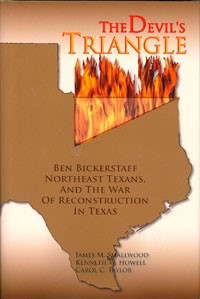
In 2007 James Smallwood, Kenneth Howell and I worked together to write the story of the unsettled region of northeast Texas following the Civil War. We discovered that Ben Bickerstaff and his fellow terrorists seldom walked when a horse or mule was handy. They were determined to undo Reconstruction, using tactics they acquired in the Civil War.
Most of my followers understand my love of horses and dogs. But last Saturday when Justify led the pack from start to finish at Elmont, New York, I was mopping the floor from a water leak upstairs. I missed the Belmont Stakes but have since watched the rerun. Again, Justify is an amazing horse. Trainer Bob Baffert calls the horse “durable.”
Horse racing was probably the earliest competitive sport in North Texas. I think it was the availability of flat stretches on the numerous prairies and the fact that a horse was one of the limited means of transportation. Who would think of racing a mule or ox?
North of Greenville, between the Middle and South Sulphur Rivers was an opening in Black Cat Thicket. Supposedly there were two or three salt licks that lured all sorts of feral animals. Early settlers used it for their domestic animals. That’s when the idea of putting the oval shaped space into use as the Devil’s Racetrack. No one knows when racing began there or even when it ended. Most interviews with early settlers mentions races held at Devil’s Racetrack. Some even mention that young men from Choctaw Nation brought their best horses and usually won the race.
One delightful nonagenarian I know told me that in the early 1900s young ladies borrowed their fathers’ buggies and horses for a Sunday afternoon drive. Somehow they mysteriously found themselves at Devil’s Racetrack where young men gathered for recreation. Something tells me the young ladies had a little pocket change to bet on their beaux’s horse.
But horse racing was not the only event horses participated in. During the Civil War, many cavalry units were dismounted for lack of horses. After the Battle at Gettysburg, women, children and old men had to dispose of dead horses and mules. By the time General Robert E. Lee surrendered to General U. S. Grant, the vast majority of Confederate soldiers were without mounts. Those men were told to travel in small groups of three to five, were given one shotgun for the group to be used for protection, and told to forage on their way home.
For those veterans who hiked back to Texas the journey was unbelievably difficult. However, I find that when they crossed into Texas horses were available. For the next five years or more many of those veterans and the young men who were too young to fight in the war created havoc on former slaves, white Unionists and Union soldiers.
The Sixth Cavalry U. S. occupied most of the counties along the northern part of Texas. Noted outlaw Ben Bickerstaff and his men gathered around the town of Sulphur Springs. John Vaden was one of those young rabble-rousers. In mid-August Vaden staged a one-man raid on Sulphur Springs by riding his racehorse, a sorrel mare, down the main street. As he passed within forty feet of the military stockade, he fired a couple of wild shots to announce his presence. He rode past the local hotel where officers and their wives were quartered. He spied Captain Tolman and his wife sitting on the hotel gallery. The hotspur leaned under the neck of his horse and fired a round that missed Tolman’s head by inches. As he continued his ride, he saw a freedman known as “Old Grimes”, a leader of the local black community. Vaden gunned Grimes down while continuing his dash out of town. By the time the Federal Army put together a patrol to pursue, Vade had vanished into the countryside.
I did a study once of the number of horses here in Hunt County in 1870. A large number of young men about the age of Vaden paid taxes on horses, no cattle, no cotton, and no crops. As Jim Smallwood, Ken Howell, and I wrote The Devil’s Triangle: Ben Bickerstaff, Northeast Texas, and the War of Reconstruction in Texas, we discovered an abundance of horses and mules in the region. Of course, the Union control of the Mississippi River prevented horses being sent to the battlefields. The paragraph about John Vaden was taken from the book.
Today when the economy is thriving the number of horse farms is quite large. Who can’t love a horse?
